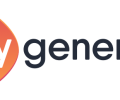I’m still all fired up by the learning solution conference of last week. During one session we had to answer the question: “Where will you be in 5 years from now”. I will answer it in this post: so it is time for some daydreams.
For me personally I hope and expect that I will still be working at easygenerator. By then we are recognized as the best learning content platform in the world, we will have an active network of partners in 121 countries and we will have more end users than we can count. But probably you couldn’t care less.
What might be interesting to you is where our learning content will be and what will happen with it. Inspired by the learning landscape of Will Tallheimer I created a content landscape. This is how I dream that that landscape will look like in five years’ time.
 Ok, instead of easygenerator in the middle, it should have said ‘any content management or authoring system’, but it’s my dream so I can do what I want. Here are the details.
Ok, instead of easygenerator in the middle, it should have said ‘any content management or authoring system’, but it’s my dream so I can do what I want. Here are the details.
From the authoring tool (easygenerator) perspective
Content management and authoring tools are completely open, allowing authors to pull in information from anywhere and to publish to all kinds of systems. Easygenerator has no functionality to create images, flash or any other type of media content. There are great tools available that do just that. Easygenerator is the content integrator, enabling authors to gather, organize and publish all kinds of learning content and to create and maintain text in multiple languages. It supports open standards that enable you to connect to all kind of media on the web and any type of content that you have produced in any other tool. You can freely pull that information in, our push it out and it will work flawless in all systems on all platforms. Learning content is tagged for context, so it knows what is it about, for whom it is and when to show itself. Learning content is published in all kind of systems: Learning Managements Systems, Knowledge Management Systems, Social networks, internet, intranet and Electronic Performance systems. They closely work together in presenting relevant information in an active way to the learner precisely when he needs it.
From the author’s perspective
Authors will create learning material, harvesting all source materials from the web, gathering it from SME’s through social media, working together with designers, managers, SME’s, project managers. Content is re-used a lot and the structure of courses is languages independent, so you can maintain courses in many languages with that one structure. Context is added in the form of meta data, most of the tags are generated automatically, some of them added by authors or by end users of the content. Authors have reports on the usage of courses and topics and the will get loads of user feed back (like/dislike and comments) they adjust the content based on this input. If they change anything, it is available to users within seconds.
From the learners perspective
A learner who has an question or a problem is supported because there is a lot of information available about him that creates a user context. Based on location, preferences, previous issues, education, function, current usage of systems a context is automatically defined. The content is also context aware. Whenever a user activates a help or learning system relevant information is automatically presented using filters that apply both contexts. Users can add to content or comment on content (based on rights and type of content) and indicate whether they like content or not.
Probably I can come up with a lot more, but you will hopefully get my drift.



